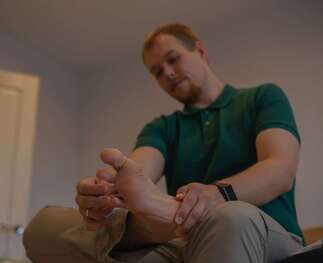Plantar fasciitis- dealing with heel pain
Plantar fasciitis (fasciopathy) is a painful condition resulting in pain and tenderness under the heel. It is often caused by overuse of the plantar fascia or “arch tendon” of the foot. The plantar fascia is a broad, thick band of tissue that runs from the calcaneus (heel) to the heads of the metatarsals at the base of the toes. This condition is most common in runners and walkers who overpronate (excessive rolling in or flattening of the foot).
What Causes Plantar Fasciitis?
The most common cause of plantar fasciitis is poor biomechanics or lower limb alignment. Tight calf muscles can also contribute to overpronation of the foot, flattening the arch and placing excessive tensile stress on the plantar fascia.
Repetitive over stretching of the plantar fascia leads to irritation and thickening of the tissue, most commonly at the attachment to the medial calcaneus. As the fascia thickens it loses its natural flexibility and strength. The pain associated with this condition is thought to be due to degeneration of the fascia at the calcaneal attachment.
Prolonged walking or running in footwear that doesn’t provide adequate support, especially under the arches, is often a major contributing factor. Overweight individuals are also more prone to plantar fasciitis due to the increased weight and forces going through the feet with each step they take.
Symptoms of Plantar Fasciitis…
- Local pain and tenderness under the heel, usually medially, at the attachment of the fascia and sometimes along the rest of the arch;
- Pain is usually worst first thing in the morning. It tends to ease as the foot warms up and stretches;
- As the condition worsens, pain can increase throughout the day with increased activity and weight-bearing;
- Stretching the plantar fascia passively may reproduce pain;
- At times the lateral border of the foot also becomes painful. This may be due to the person offloading the painful side of the heel by putting more weight through the outside of the foot.
How is Plantar Fasciitis treated?
- Avoid or minimise any aggravating activities. The fascia must be rested or at least offloaded until it is no longer painful or it becomes almost impossible to settle. Continual weight-bearing on the affected foot will continually aggravate the condition.
- Local ice and massage is helpful to relieve symptoms.
- Stretching of the posterior chain (hamstrings, calf and plantar fascia) is very important.
- Biomechanical assessment is critical. If the lower limb biomechanics are not right, the condition will never fully resolve. Strapping/taping of the foot and fascia or prescription of appropriate orthotics will reduce symptoms significantly and allow healing to occur if they are indicated. We have had great success with this approach here at The Physio Nook.
I hope this summary will help you or someone you know. As always, we are here at The Physio Nook to help out with any musculoskeletal disorders you may have, feet or otherwise! Feel free to call us, email, or drop in for a great service.
Paul Woodward
Principal Physiotherapist
The Physio Nook.
The most common cause of plantar fasciitis is poor biomechanics or lower limb alignment. Tight calf muscles can also contribute to overpronation of the foot, flattening the arch and placing excessive tensile stress on the plantar fascia.
Repetitive over stretching of the plantar fascia leads to irritation and thickening of the tissue, most commonly at the attachment to the medial calcaneus. As the fascia thickens it loses its natural flexibility and strength. The pain associated with this condition is thought to be due to degeneration of the fascia at the calcaneal attachment.
Prolonged walking or running in footwear that doesn’t provide adequate support, especially under the arches, is often a major contributing factor. Overweight individuals are also more prone to plantar fasciitis due to the increased weight and forces going through the feet with each step they take.
Symptoms of Plantar Fasciitis…
- Local pain and tenderness under the heel, usually medially, at the attachment of the fascia and sometimes along the rest of the arch;
- Pain is usually worst first thing in the morning. It tends to ease as the foot warms up and stretches;
- As the condition worsens, pain can increase throughout the day with increased activity and weight-bearing;
- Stretching the plantar fascia passively may reproduce pain;
- At times the lateral border of the foot also becomes painful. This may be due to the person offloading the painful side of the heel by putting more weight through the outside of the foot.
How is Plantar Fasciitis treated?
- Avoid or minimise any aggravating activities. The fascia must be rested or at least offloaded until it is no longer painful or it becomes almost impossible to settle. Continual weight-bearing on the affected foot will continually aggravate the condition.
- Local ice and massage is helpful to relieve symptoms.
- Stretching of the posterior chain (hamstrings, calf and plantar fascia) is very important.
- Biomechanical assessment is critical. If the lower limb biomechanics are not right, the condition will never fully resolve. Strapping/taping of the foot and fascia or prescription of appropriate orthotics will reduce symptoms significantly and allow healing to occur if they are indicated. We have had great success with this approach here at The Physio Nook.
I hope this summary will help you or someone you know. As always, we are here at The Physio Nook to help out with any musculoskeletal disorders you may have, feet or otherwise! Feel free to call us, email, or drop in for a great service.
Paul Woodward
Principal Physiotherapist
The Physio Nook.


